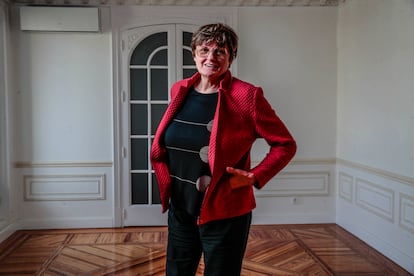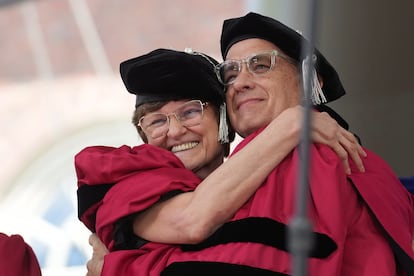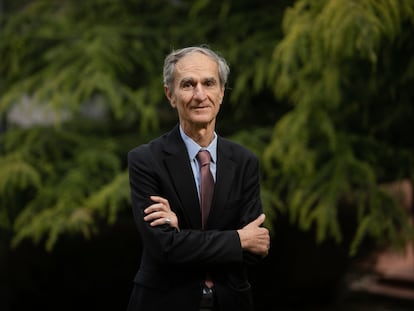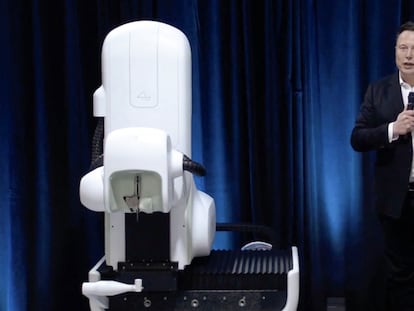Katalin Karikó, molecular biologist: ‘One of the patients who responded to the RNA vaccine had metastasis and her tumors disappeared’
The pioneer of messenger RNA immunizations reflects on new treatments against viruses, bacteria and cancer

Katalin Karikó is one of the creators of messenger RNA vaccines, which have saved millions of lives all over the world. The powerful technology was the basis for the Covid-19 vaccines, and it will now become the basis for new immunizations against other infectious diseases, as well as possibly for chronic illnesses like cancer.
At the end of the 1970s, the molecular biologist migrated from Hungary to the United States with her husband and two-year-old daughter, along with $1,200 of savings hidden in a teddy bear.
Karikó began working against the tide and without funding. She was looking for a way to turn RNA, a molecule complementary to DNA that does almost all the work of creating life, into a therapy. In 2005, along with her University of Pennsylvania colleague Drew Weissman, she demonstrated that modifying just one letter in the RNA sequence prevented the molecule from provoking an immune response. Some years later, Moderna and BioNTech used the discovery to create their messenger RNA vaccines against Covid, created in record time.
Despite having received more than 100 awards since 2020 alone, the scientist’s humility stands out. She received the Commemorative Lesson Prize from the Conchita Rábago de Jiménez Díaz foundation in Madrid, and she has been named doctor honoris causa by Harvard and Princeton. Her tour around the world will continue for several months. But during her career, Karikó never received tenure at her own university: the institution demoted her because she failed to receive funding. Karikó has retired from her position as vice-president of BioNTech, though she will remain a consultant at the company, and she explains that she has begun a new phase in life. She is one of the strongest candidates for the Nobel prizes.
Question. After so much time working outside the spotlight, how do you feel receiving so much recognition?
Answer. It is part of the work. You do the work of writing the interview, I try to help you out and together we educate the public. We need that because they are so behind, and they want to understand things. We have to find a way to explain complex things to them and try to inspire the new generation, because less and less people want to go into science. It is difficult. They want easy money or something, and they don’t realize that money won’t make you happy. I don’t think about these prizes. I respect and I understand the importance of the prizes to bring attention to the science. That’s what is important to me, the science, and to inspire people.
Q. Have you been happy?
A. I was very happy and very successful. I felt the success because as I did more and more experiments, I got better results. I didn’t get the money to support the research, but the success was to progress in the experiments: find a way to produce more protein with the RNA, modify the sequence and make it work better, see that it works in animals. They tried to demote me four times. If they hadn’t, I wouldn’t be who I am. Do not feel sorry for yourself and lick your wounds. The only thing that matters is the next step you take.
Q. What will be your next step?
A. I’m not going back to academic research because I never succeeded in that world. The University of Pennsylvania retired me 10 years ago, although they keep me as an adjunct professor. Now I’m starting a new chapter of my life. I always think it will be the last chapter. At BioNTech I am a consultant and I have my own team. I talk to them every week. They already know what they have to do and they also have money to do it.
Q. After the Covid vaccines, what will come next?
A. Prior to Covid, Moderna and BioNTech were already working on a messenger RNA influenza vaccine. This will probably be the next one, along with the respiratory syncytial virus, which Moderna is developing. This company also has two ongoing trials of a vaccine against HIV and also against the Epstein-Barr virus, which could be the cause of multiple sclerosis. There is also a new experimental vaccine against nipah [an emerging virus in Asia that has a mortality of between 40% and 75%]. It is interesting that both Moderna and BioNTech have announced that they are developing RNA vaccines against shingles. There is already one, but it costs about €800 ($852). The advantage of mRNA vaccines is that they are cheap and can be developed very quickly.

Q. Do messenger RNA vaccines only have applications against viruses?
A. No. They can also be very useful against infections caused by bacteria. There is an experimental vaccine in development against borreliosis, which is transmitted by a tick bite, and another against tick-borne encephalitis. In the latter, there is an RNA vaccine in the animal testing phase that is based not on immunizing against proteins of the pathogen, but against proteins that are in the saliva of ticks, so that they generate immunization from the moment the insect bites. And we also have the messenger RNA vaccine against malaria.
Q. A few days ago, BioNTech presented promising results for an RNA vaccine against pancreatic cancer, the deadliest. What can we expect from it?
A. Pioneering messenger RNA vaccine companies, such as Curevac, founded in 2000, and BioNTech, in 2008, began by looking at immunizations against cancer. It is a long scientific process that corrects itself as there are new results about the human immune system and the complexity of cancer. The latest results from BioNTech have shown that if the patient has an operable tumor, it is possible to develop a vaccine against epitopes [proteins] unique to the tumor. This is an advance because it was thought that in this tumor it was impossible. But the treatment only worked in half the patients.
Q. Do you know why?
A. No. It should be noted that the 16 patients in this clinical trial had undergone several courses of treatment with various drugs. They were on their last rope. His immune system was already very weak, although it was still working. What we needed was to generate immunity mediated by killer T lymphocytes [a class of white blood cell]. Eight responded, and 18 months later they did not see their cancer come back. Eight others did not respond and relapsed. One of the patients who responded had metastases, and yet his tumors disappeared. We do not know why. We did see that the non-responders had slightly larger tumors. This is an initial trial with few patients, so we cannot generalize. Now we have to keep accumulating information and understand why some people react and others don’t. Such is science.
Q. A few weeks ago, a Moderna executive predicted that some cancer vaccines could be ready in five years, and the founders of BioNTech also made similar statements. Do you agree?
A. No way. No one should say those things. Cancer is too complex. Each type of tumor has its specificities. Those predictions are very damaging for people with cancer. It’s playing with your hope. When I started at BioNTech in 2013, lung cancer was practically a death sentence. Then came checkpoint inhibitor immunotherapy, which allowed more and more people to survive this tumor. Now there are still tumors that are invisible to the immune system and we need more research to find out why. The good thing is that there is now a lot of money for the development of new vaccines and treatments based on messenger RNA.
Q. Could messenger RNA help cure Alzheimer’s and other neurological conditions?
A. The problem with messenger RNA is that no matter how well you wrap and encapsulate it, it’s very difficult for it to cross different tissues, different layers of cells. As soon as it finds a cell, it captures it, reads its instructions and makes a protein with them. That is why it is very useful when you need to secrete a certain protein, such as the coronavirus spike. But if you’re trying to replace a protein that’s already there [Alzheimer’s is associated with the buildup of two dysfunctional proteins, amyloid and tau], RNA can’t help. We did the test by introducing it into the cerebrospinal fluid of mice and we saw that the messenger RNA never reached the neurons. It is difficult to bring treatment to neurons threatened by Alzheimer’s or Parkinson’s. I’m not saying it can’t, but a lot of research is needed. That being said, it has been seen to be effective in the spinal cord. And also in the treatment of amyloidosis and heart failure.
Q. Your daughter, Susan Francia, is a rower and won two Olympic medals with the United States. You compare science with this sport. Why?
A. Have you noticed that you row with your back to the direction of travel? So is science. You don’t see the finish line. You don’t even know that there is a finish line. You don’t even know that you are going in the right direction. But you keep working.
Sign up for our weekly newsletter to get more English-language news coverage from EL PAÍS USA Edition
Tu suscripción se está usando en otro dispositivo
¿Quieres añadir otro usuario a tu suscripción?
Si continúas leyendo en este dispositivo, no se podrá leer en el otro.
FlechaTu suscripción se está usando en otro dispositivo y solo puedes acceder a EL PAÍS desde un dispositivo a la vez.
Si quieres compartir tu cuenta, cambia tu suscripción a la modalidad Premium, así podrás añadir otro usuario. Cada uno accederá con su propia cuenta de email, lo que os permitirá personalizar vuestra experiencia en EL PAÍS.
¿Tienes una suscripción de empresa? Accede aquí para contratar más cuentas.
En el caso de no saber quién está usando tu cuenta, te recomendamos cambiar tu contraseña aquí.
Si decides continuar compartiendo tu cuenta, este mensaje se mostrará en tu dispositivo y en el de la otra persona que está usando tu cuenta de forma indefinida, afectando a tu experiencia de lectura. Puedes consultar aquí los términos y condiciones de la suscripción digital.
More information
Últimas noticias
Maduro pleads not guilty before the federal court in New York: ‘I am still the president of Venezuela’
A new test can detect Alzheimer’s from a finger prick
UN team enters Sudanese city of El Fasher after paramilitary massacre: ‘It’s like a ghost town’
A recipe for resistance: Indigenous peoples politicize their struggles from the kitchen
Most viewed
- Gilles Lipovetsky: ‘If you want to live better and fall in love, take Prozac, don’t look to philosophy’
- Alain Aspect, Nobel laureate in physics: ‘Einstein was so smart that he would have had to recognize quantum entanglement’
- Alvin Hellerstein, a 92-year-old judge appointed by Bill Clinton, to preside over Maduro’s trial in New York
- Why oil has been at the center of Venezuela-US conflicts for decades
- Maduro’s downfall puts China’s relationship with Venezuela to the test











































